Installing a fan case in your computer might seem daunting, but it’s a surprisingly straightforward process with the right guidance. Whether you’re building a new PC or looking to improve your existing setup’s cooling, this guide will walk you through each step. From choosing the right fan case to mounting it correctly, we’ve got you covered.
Understanding Fan Cases and Their Importance
Before diving into the installation process, let’s clarify what a fan case is and why it’s crucial for your computer. A fan case, often referred to as a case fan, is a small fan designed to circulate air inside your computer case. It works by pulling cool air in and expelling hot air out, preventing your components from overheating.
Overheating can lead to decreased performance, system instability, and even permanent damage to your hardware. Installing a fan case, or multiple fans, ensures efficient airflow, keeping your components cool and operating at their best.
Choosing the Right Fan Case for Your Needs
Not all fan cases are created equal. They come in various sizes, speeds, and noise levels. Consider these factors when selecting a fan case:
- Size: The most common sizes are 80mm, 120mm, and 140mm. Ensure your case has the appropriate mounting points for your chosen size.
- Airflow: Measured in cubic feet per minute (CFM), higher CFM means more air movement and better cooling.
- Noise Level: Measured in decibels (dB), consider your noise tolerance. Some fans offer quieter operation than others.
- Static Pressure: Important if the fan will be pushing air through obstructions like radiators or heatsinks.
Installing Your Fan Case: A Step-by-Step Guide
Now, let’s get to the heart of the matter: installing your fan case. Follow these steps for a smooth and successful installation:
- Prepare Your Workspace: Find a clean, well-lit area and gather your tools, including a screwdriver, zip ties or fan screws, and your chosen fan case.
- Open Your Computer Case: Power down your PC, unplug it, and open the side panel to access the interior.
- Determine Fan Placement: Identify the intake and exhaust fan positions in your case. Typically, front and bottom are intake, while rear and top are exhaust.
- Mount the Fan: Align the fan with the mounting holes in your case. Use screws or zip ties to secure it firmly.
- Connect the Fan: Connect the fan’s power connector to the appropriate header on your motherboard. Consult your motherboard manual if needed.
- Manage Cables: Neatly route the fan’s cable and secure it with zip ties to prevent obstruction of airflow.
- Close and Test: Close your case, power on your PC, and check if the fan is spinning correctly.
Tips for Optimal Fan Case Performance
 Optimizing Fan Setup for Airflow
Optimizing Fan Setup for Airflow
To maximize your fan case’s effectiveness, consider these tips:
- Create Positive Air Pressure: Install more intake fans than exhaust fans to create positive pressure inside your case, forcing dust out.
- Clean Regularly: Dust accumulation can hinder airflow. Clean your fans and case interior regularly to maintain optimal cooling.
- Monitor Fan Speeds: Use software to monitor fan speeds and adjust them based on your system’s temperature.
- Consider a Fan Controller: For greater control over fan speeds and noise levels, invest in a dedicated fan controller.
Conclusion
Installing a fan case is an essential step in building or maintaining a well-cooled PC. By following this guide and considering the factors discussed, you can ensure optimal airflow, prolong the lifespan of your components, and enjoy a stable and high-performing system.
FAQs About Installing a Fan Case
1. How many fans do I need in my PC?
The ideal number depends on your case size, hardware, and desired noise levels. At least one intake and one exhaust fan are recommended for basic cooling.
2. Can I add fans to a pre-built PC?
Yes, most pre-built PCs have space for additional fans. Ensure compatibility with your case and motherboard.
3. Which direction should the fan face?
The fan’s airflow direction is usually indicated by an arrow on the fan frame. Ensure it aligns with the intake or exhaust orientation.
4. What is PWM fan control?
Pulse Width Modulation allows for more precise fan speed control based on temperature readings.
5. Do I need thermal paste when installing a fan?
You don’t need thermal paste when installing a case fan, but it is crucial when installing a CPU cooler.
6. Can I use a fan splitter for multiple fans?
Yes, fan splitters allow you to connect multiple fans to a single motherboard header.
7. What are some good fan case brands?
Popular and reputable fan case brands include Noctua, Corsair, be quiet!, Cooler Master, and NZXT.
For those looking for more specific guidance, we have detailed articles on how to install fan case into motherboard and installing fans for specific cases. We also have a handy guide on ensuring your case fan is installed the right way round. For those working with specific models like the Vitra Cooling Ring RGB, we have a dedicated installation guide.
If you need further assistance or have any questions, please don’t hesitate to contact us. Our team is available 24/7 to provide support. You can reach us at Phone Number: 0903426737, Email: fansbongda@gmail.com, or visit us at Tổ 9, Khu 6, Phường Giếng Đáy, Thành Phố Hạ Long, Giếng Đáy, Hạ Long, Quảng Ninh, Việt Nam.


